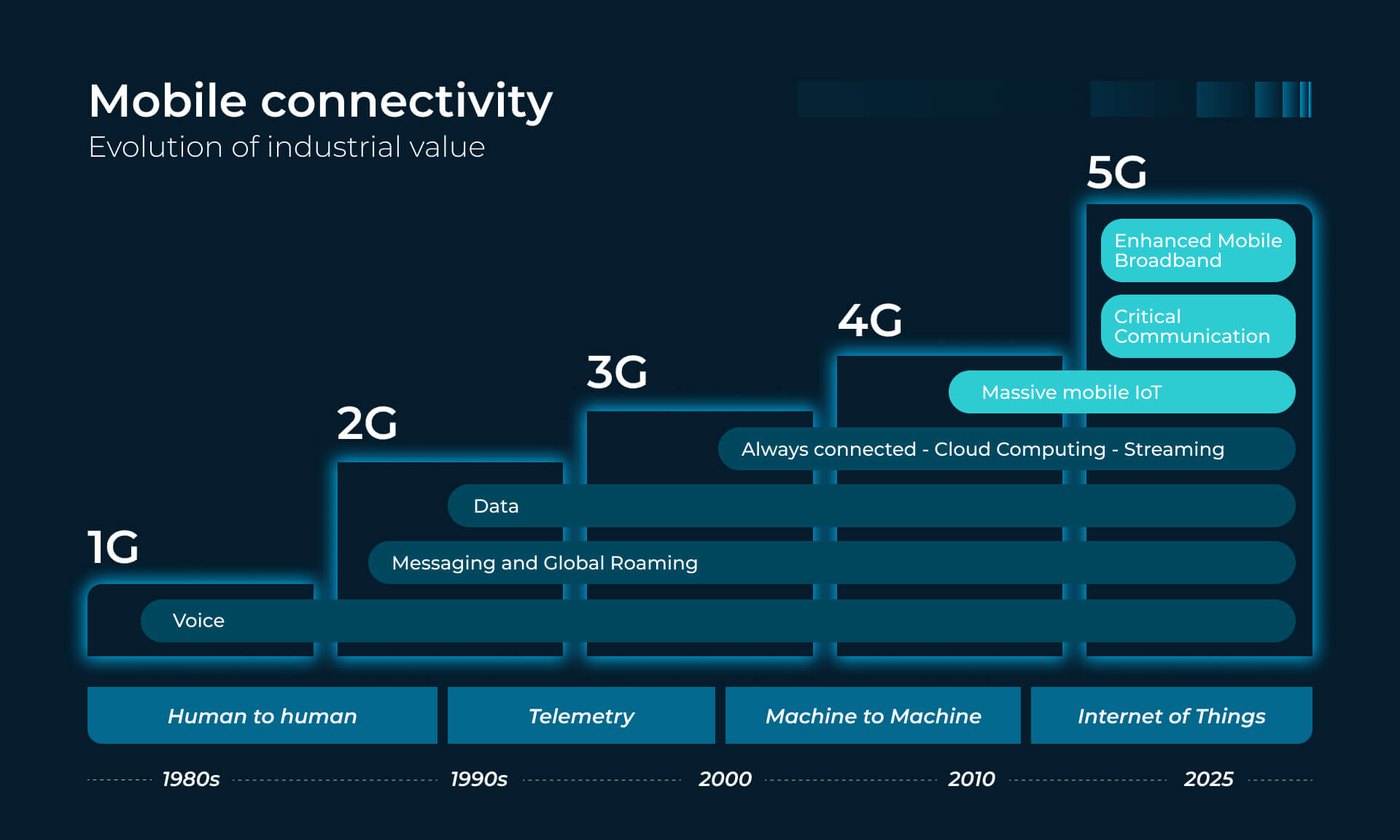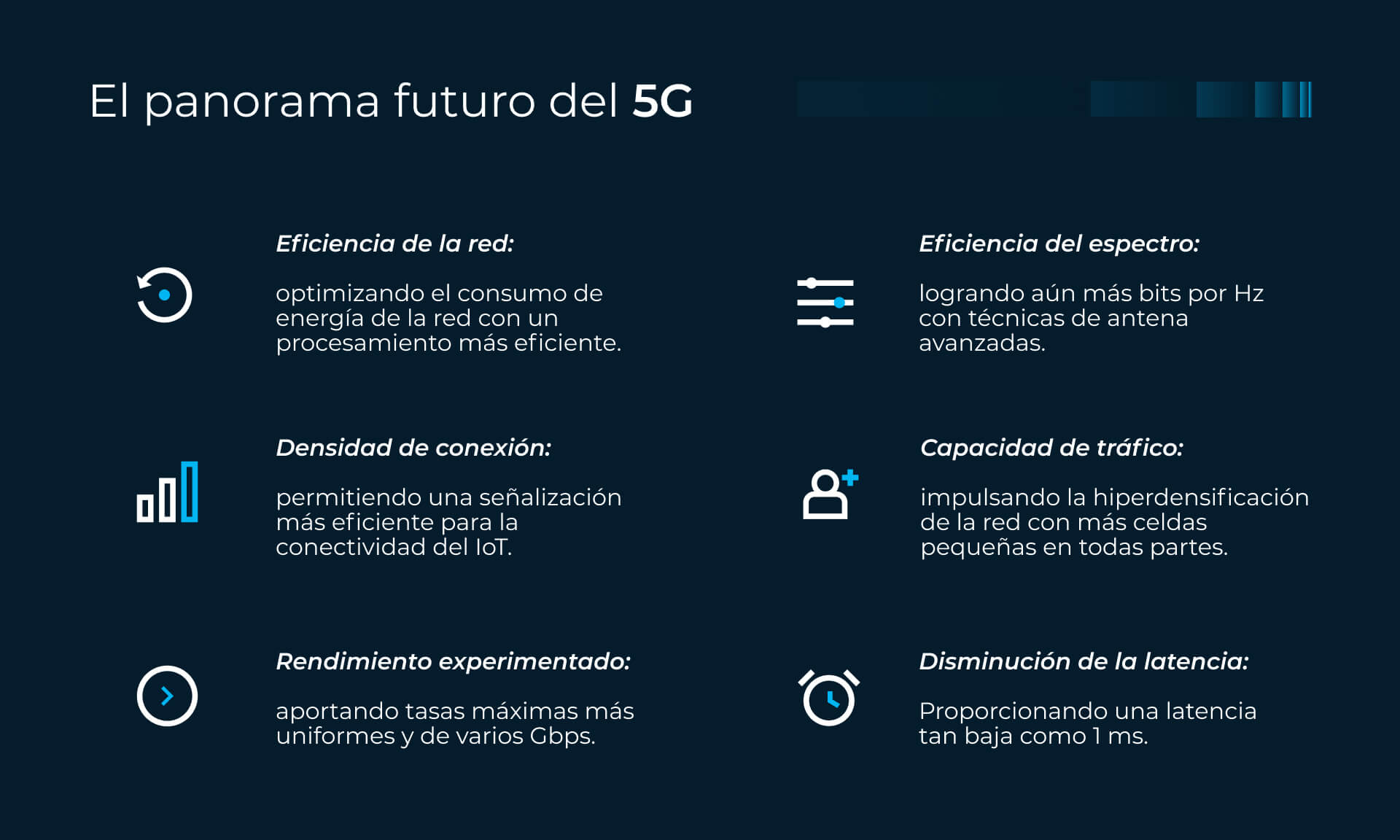Elena Canorea
Communications Lead
El IoT o Internet of Things está en pleno auge, dado el aumento de los dispositivos conectados y, especialmente, a la evolución del IoT empresarial.
Gracias a los avances en conectividad, el IoT va a experimentar un despegue aún mayor, impulsado en gran medida por el 5G. Pero ¿hasta qué punto se necesitan el uno al otro? ¿Qué relación tienen el 5G y el IoT en el desarrollo empresarial? ¿Qué oportunidades van a brindar a los negocios?
Nos encontramos en un momento en el que el servicio móvil 5G ha comenzado a generalizarse, lo que supone una gran noticia, pues estas redes están contribuyendo a mejorar el rendimiento y la confiabilidad de los dispositivos conectados.
Esta red está configurada para impulsar la transformación digital a nivel mundial, y así estimular la innovación y transformar las industrias. A medida que las empresas recurran a redes de próxima generación y sensores, sus negocios mejorarán significativamente.
Si hablamos del éxito comercial del IoT, estaríamos hablando de su rendimiento y su dependencia de la rapidez con la que puede comunicarse con otros dispositivos inteligentes. Por ello, el 5G es un factor fundamental para aumentar la velocidad de transferencia de datos.

A pesar de los problemas derivados de la escasez de chips, el mercado global de IoT creció un 22% en 2021 hasta alcanzar casi los 158.000 millones de dólares. De hecho, se espera que esta cifra aumente a 3.200 millones en 2023 y hasta 525.000 millones en 2027.
Por otra parte, las ofertas de trabajo relacionadas con el IoT crecieron un 41% entre julio de 2021 y marzo de 2022, lo que, a su vez, supone un gran problema a la hora de encontrar personal especializado en este campo, dada la alta demanda de proyectos.
Si hablamos de las perspectivas de futuro del 5G, se prevé que será 10 veces más rápido que las redes LTE actuales, un punto fundamental para que los dispositivos se comuniquen y compartan datos más rápido que nunca.
Estamos viendo que el 5G influye notablemente en el funcionamiento de los dispositivos IoT, ya sea para aplicaciones industriales, de atención médica o de uso doméstico.
La convergencia de ambas tecnologías afectará a prácticamente todos los componentes del IoT, ya sea de forma directa o indirecta; a los sensores les ofrece un mayor ancho de banda para transferir la información más rápido y aumentar su funcionalidad.

El 5G es la primera red móvil diseñada desde cero para admitir casos de uso de IoT, y permitirá la aparición de nuevos casos de uso y mejorar la eficiencia o existir a mayor escala de los 4G ya existentes. Algunos ejemplos son:
La transmisión masiva de vídeo móvil permitirá la reparación y mantenimiento de maquinaria compleja de forma remota. Esto se traduce en ahorro en costos de viaje y personales al reducir el desplazamiento de los expertos. Estos se sitúan en una ubicación central, para asistir a personal menos capacitado, robots o una combinación de ambos.
El 5G permite a los médicos tratar a pacientes en áreas rurales de forma remota, incluso realizando cirugía a distancia.
La comunicación crítica 5G permitirá casos de uso en los que los dispositivos y máquinas IoT interactúen entre sí. Para que sea posible, se necesita una conexión muy rápida y confiable que aporta el 5G.
Dará una respuesta rápida desde la nube con un enfoque descentralizado y redes locales más pequeñas que mejoran la seguridad al elegir una nube privada.
Los vehículos autónomos también pueden beneficiarse de esta respuesta rápida, confiable y con seguridad mejorada gracias al 5G. Los vehículos y robots en ubicaciones industriales serán los primeros en surgir, pero hay que tener en cuenta otros aspectos como la responsabilidad y la privacidad del consumidor.
La tecnología 5G permite habilitar dispositivos con hardware más simple y eficiente que necesitan una batería de larga duración. Estos dispositivos pueden enviar información sobre su ubicación durante meses o años, como sensores en edificios inteligentes, para seguimiento de activos, protección contra robos, etc.
Actualmente, estamos solo en la primera fase de transición del 5G, pero las empresas que quieran aprovechar todas sus capacidades nuevas deben asegurarse de trabajar con socios que sepan encontrar la solución que mejor se ajuste a cada negocio. En Plain Concepts te ayudamos a superar estos desafíos y tus opciones de conectividad.
Elena Canorea
Communications Lead
